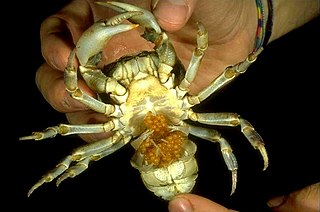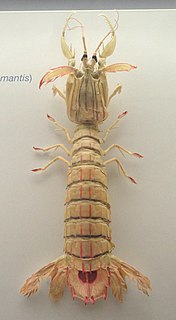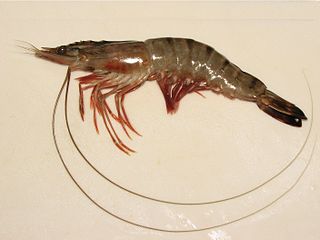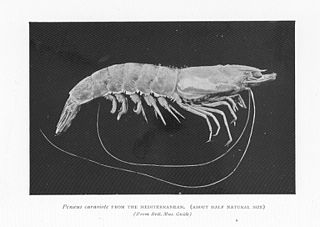
The Caridea, commonly known as caridean shrimp or true shrimp, are an infraorder of shrimp within the order Decapoda. This infraorder contain all species of true shrimp. They are found widely around the world in both fresh and salt water. Many other animals with similar names – such as ghost shrimps, mud shrimps, and boxer shrimps – are not true shrimps, but many have evolved features similar to true shrimps.

Dendrobranchiata is a suborder of decapods, commonly known as prawns. There are 540 extant species in seven families, and a fossil record extending back to the Devonian. They differ from related animals, such as Caridea and Stenopodidea, by the branching form of the gills and by the fact that they do not brood their eggs, but release them directly into the water. They may reach a length of over 330 millimetres (13 in) and a mass of 450 grams (1.0 lb), and are widely fished and farmed for human consumption.

The Decapoda or decapods are an order of crustaceans within the class Malacostraca, including many familiar groups, such as crayfish, crabs, lobsters, prawns, and shrimp. Most decapods are scavengers. The order is estimated to contain nearly 15,000 species in around 2,700 genera, with around 3,300 fossil species. Nearly half of these species are crabs, with the shrimp and Anomura including hermit crabs, porcelain crabs, squat lobsters making up the bulk of the remainder. The earliest fossil decapod is the Devonian Palaeopalaemon.

Pleocyemata is a suborder of decapod crustaceans, erected by Martin Burkenroad in 1963. Burkenroad's classification replaced the earlier sub-orders of Natantia and Reptantia with the monophyletic groups Dendrobranchiata (prawns) and Pleocyemata. Pleocyemata contains all the members of the Reptantia, as well as the Stenopodidea, and Caridea, which contains the true shrimp.

The Stenopodidea or boxer shrimps are a small group of decapod crustaceans. Often confused with Caridea shrimp or Dendrobranchiata prawns, they are neither, belonging to their own group.

Mirocaris is a genus of shrimp associated with hydrothermal vents. Sometimes considered the only genus of the family Mirocarididae, Mirocaris is usually placed in the family Alvinocarididae. The genus contains two species, M. fortunata and M. indica; the former species M. keldyshi is now considered synonymous with M. fortunata. The two species are found in different oceans, and can be distinguished by the pattern of setation on the claw of the first pereiopod.

Palaemon is a genus of caridean shrimp of the family Palaemonidae. The conventional circumscription of the genus Palaemon is probably paraphyletic. Molecular data suggest that Palaemonetes, as well as the genera Exopalaemon and Couteriella, are nested within Palaemon. Phylogenetic affinities in these groups correspond better with geographical origin than conventional genus assignments.

Palaemon affinis is a species of shrimp of the family Palaemonidae. Early authors used the name Palaemon affinis for specimens now known to belong to a variety of species, but P. affinis is now known to be endemic to the waters of New Zealand.

Squilla mantis is a species of mantis shrimp found in shallow coastal areas of the Mediterranean Sea and the Eastern Atlantic Ocean: it is also known as "pacchero" or "canocchia". Its abundance has led to it being the only commercially fished mantis shrimp in the Mediterranean.

Palaemon serratus, also called the common prawn, is a species of shrimp found in the Atlantic Ocean from Denmark to Mauritania, and in the Mediterranean Sea and Black Sea.

The phyllosoma is the larval stage of spiny, slipper and coral lobsters, and represents one of the most significant characteristics that unify them into the taxon Achelata. Its body is remarkably thin, flat, and transparent, with long legs.

Heterocarpus is a genus of deep-sea shrimp, mainly of tropical areas all over the world.

Lysmata is a genus of shrimp in the infraorder Caridea, the caridean shrimp. The genus belongs to the family Lysmatidae. Lysmata are popular ornamental shrimp in the marine aquarium trade for their bright color patterns, interesting behaviors, and ability to control certain aquarium pests such as sea anemones of the genus Aiptasia. They are known to command high prices on the pet market.

Palaemon adspersus, commonly called Baltic prawn, is a species of shrimp that is frequent in the Baltic Sea, and is the subject of fisheries in Denmark. It is up to 70 mm (2.8 in) long, and lives in Zostera beds.

Stenopus spinosus is a shrimp-like decapod crustacean belonging to the infraorder Stenopodidea.

Shrimp are decapod crustaceans with elongated bodies and a primarily swimming mode of locomotion – most commonly Caridea and Dendrobranchiata. More narrow definitions may be restricted to Caridea, to smaller species of either group or to only the marine species. Under a broader definition, shrimp may be synonymous with prawn, covering stalk-eyed swimming crustaceans with long narrow muscular tails (abdomens), long whiskers (antennae), and slender legs. Any small crustacean which resembles a shrimp tends to be called one. They swim forward by paddling with swimmerets on the underside of their abdomens, although their escape response is typically repeated flicks with the tail driving them backwards very quickly. Crabs and lobsters have strong walking legs, whereas shrimp have thin, fragile legs which they use primarily for perching.

Prawn is a common name for small aquatic crustaceans with an exoskeleton and ten legs, some of which can be eaten.

Melicertus kerathurus, the striped prawn or caramote prawn is a species of tiger prawn from the family Penaeidae which occurs in the eastern Atlantic and Mediterranean Sea which is an important species in commercial fisheries. It is the type species for the genus Melicertus.

Saron marmoratus, the marbled shrimp, is a species of "cleaner shrimp" from the family Thoridae, although its taxonomic position is subject to some controversy as many authorities have considered it to be a member of the family Hippolytidae sensu lato. It's normally found in the Indo-Pacific region but in 2013 it was found off the coast of Lebanon, probably having reached the Mediterranean by Lessepsian migration through the Suez Canal from the Red Sea. It is a popular species in aquaria due to its easy care.

Aristaeomorpha foliacea, the giant red shrimp or giant gamba prawn, is a species of deep water benthopelagic decapod crustacean. It is found in all the world's oceans in the temperate and tropical zones. It is subject to some commercial fishing activity in the Mediterranean Sea.

















